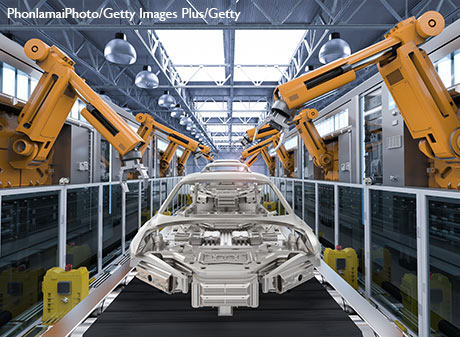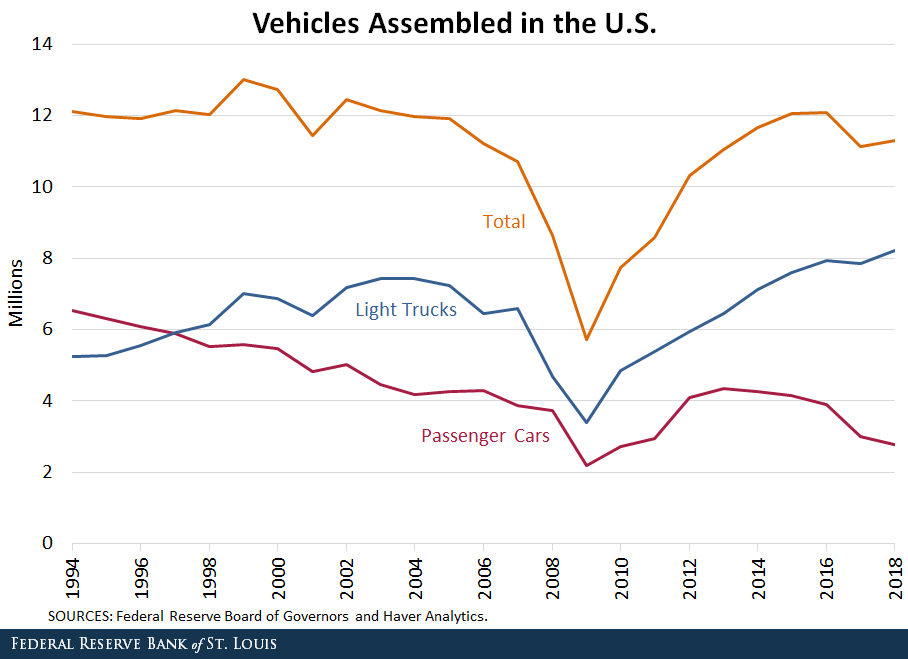Did NAFTA Shift Car Making to Other Countries?

The U.S. has one of the world’s largest auto markets, but some are concerned that free trade has disadvantaged U.S. auto competitiveness. The renegotiation of the North American Free Trade Agreement (NAFTA) exemplifies this concern, since auto trade terms received an overhaul. However, solely looking at the rising trade deficit in vehicles to conclude that NAFTA was a bad deal is misleading.
Increase in Vehicle Trade Deficit
In 1994, the U.S. ran a real trade deficit of $63 billion (in 2012 dollars) in vehicles, and this deficit nearly doubled by 2017. A common narrative is that this rising deficit reflects jobs being transplanted to other countries.
For example, if an automobile factory closes in the U.S. and reopens in another country, then the trade deficit with that country would increase as the U.S. would then import vehicles that used to be manufactured here.
Although there are examples of factories moving abroad, in net we find that the number of vehicles assembled in the U.S. remains fairly unchanged since the signing of NAFTA.
Change in Vehicles Produced in the U.S.?
The U.S. assembled 12.1 million vehicles in 1994, and this amount persisted until just before the Great Recession. The number of vehicles assembled plummeted to a low of 5.7 million in 2009 but has since recovered, as seen in the figure below.

In 2016, about 12.1 million vehicles were assembled, which is identical to the number manufactured in 1994 when NAFTA was signed. NAFTA did not greatly affect total vehicle assemblies.
Although we see a dip in 2017, this most likely reflects manufacturers adjusting supply in response to decreased U.S. demand and not the repercussions of NAFTA as U.S. auto sales also dipped in 2017.
What Types of Vehicles Are Made in the U.S.?
While the total number of vehicles assembled in the U.S. is fairly unchanged, the makeup has changed. We see that passenger car assemblies declined from 6.5 million in 1994 to 2.8 million in 2018. Meanwhile, light truck assemblies increased from 5.2 million in 1994 to 8.2 million in 2018. Essentially vehicle production shifted from cars to trucks since NAFTA.
Assembling trucks provides more value than assembling cars, so it make sense that we see this production shift. Also, since countries trade based on their comparative advantages, it is likely that some of this car production shifted abroad while domestic manufacturers shifted production to trucks.
All in all, the number of vehicles manufactured in the U.S. remains unchanged since NAFTA, but the makeup of vehicles manufactured has changed. Only focusing on the U.S.’s rising trade deficit provides an incomplete picture.
Citation
Yi Wen and Brian Reinbold, ldquoDid NAFTA Shift Car Making to Other Countries?,rdquo St. Louis Fed On the Economy, Feb. 21, 2019.
This blog offers commentary, analysis and data from our economists and experts. Views expressed are not necessarily those of the St. Louis Fed or Federal Reserve System.
Email Us
All other blog-related questions



